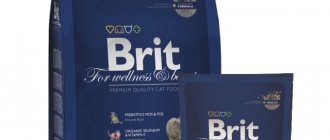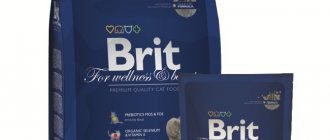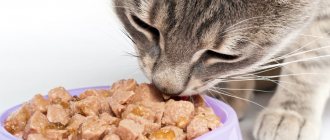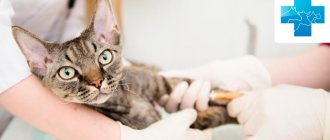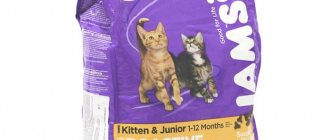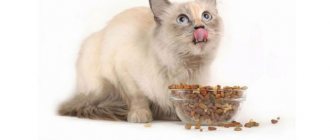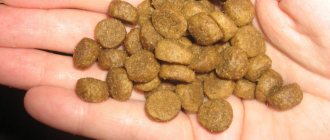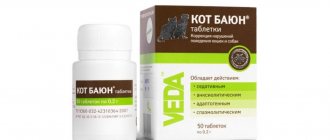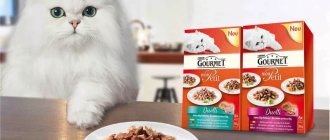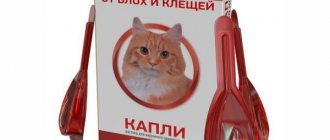Many veterinarians do not recommend giving chicken bones to a cat, much less a small kitten. Although in the wild, representatives of the cat family often hunt, including birds, it is still not recommended for pets to eat tubular bone. This is due to the fact that after a pet has eaten such food, it may vomit, and the sharp edges of the bone can damage the mucous membrane and cause bleeding and other complications. But it is still sometimes possible to occasionally treat kittens and adult cats, but you need to know how to give bones correctly.
Is it possible to give?
Experts have 2 opposing opinions on whether pets should be allowed to eat chicken necks and other bones. Some believe that a cat should not be given such dishes, since there is a high risk of injury to the mucous membrane of internal organs. Others believe that for the healthy development of the cat's body, kittens and adults need to eat bones, which contain useful components.
Veterinarians focus the attention of cat owners on the fact that only the cartilaginous bones of broiler chickens are allowed to feed the pet, while it is strictly forbidden to feed the cat chicken heads and feed raw chicken, which can lead to serious health problems.
Should I give raw or boiled meat?
Cats are carnivores, and in the wild no one cooks food for them, so the digestive system of pets can handle raw meat quite well. Therefore, such food is physiologically closer to cats. Another thing is the individual preferences of animals, which depend on what food the animal has been accustomed to since childhood.
Chicken meat is extremely rarely infected with helminths, so in this regard, a cat eating raw chicken is not in danger. Fish and other types of meat pose a great danger - for example, pork, which veterinarians generally do not recommend giving to cats.
Much more dangerous is the possible infection of a pet with salmonellosis. The causative agents of the disease are Salmonella - bacteria that remain active for a long time and are practically insensitive to low temperatures. But at +75 degrees, pathogenic microorganisms die. A 10-minute heat treatment will be enough to kill germs. A side effect of this treatment is that some of the nutrients are lost. The conclusion suggests itself: cats can have raw chicken meat, but only if it is purchased from a trusted seller and has been tested for salmonella.
Why is salmonellosis dangerous?
Salmonellosis is dangerous not only for cats, but also for humans. And more than a third of domestic animals with strong immunity that have eaten meat contaminated with salmonella will forever remain carriers of the pathology. The weakened body of a cat (small kittens, elderly animals) may not be able to cope with the infection.
The disease is always severe and accompanied by severe symptoms. You can observe in your pet:
- refusal of food;
- attacks of high fever;
- increased body temperature;
- apathy;
- diarrhea, feces have a dark, almost black color and a foul odor, and may contain streaks of blood;
- frequent vomiting with foam;
- cough;
- labored breathing.
The cat may experience severe pain in the abdomen, does not allow it to be touched, and shows aggression. With salmonellosis, the permeability of the vascular walls increases, which accelerates the penetration of pathogenic microorganisms into the body. Without prompt veterinary care, kittens, animals with low immunity and elderly animals die within 1-2 days from dehydration or sepsis.
Why can't a cat eat bones?
Sometimes fragments of such food can get stuck between the animal's teeth.
If a cat ate chicken paws or other bones once, then perhaps nothing bad will happen, but when an animal constantly eats broken chicken bones, serious health problems are possible. The seed does not have any nutritional value, but contains many useful microelements. This is the only benefit to feeding your cat chicken bones. In most cases, such a component in a cat’s diet can have dangerous consequences, even if the bones are boiled or made into bone mince. Such a diet threatens the following disorders:
- mechanical damage to the mucous membrane of the mouth, esophagus, stomach or intestines;
- hard pieces getting stuck between the teeth, which leads to gum injury;
- blockage of the digestive tract.
Tubular bones and chicken feet pose a particular danger to a cat's health. This is due to the fact that such parts have sharp edges that severely injure the mucous membrane. Spongy components are less dangerous, but can still provoke an inflammatory reaction or blockage of the esophagus. In the latter case, the cat exhibits the following unpleasant symptoms:
- constipation or diarrhea with blood in the stool;
- lethargic state;
- problems with appetite;
- repeated vomiting;
- copious amounts of saliva;
- pain during bowel movements.
What should you pay attention to when feeding your cat raw bones?
Not all bones are the same. As mentioned above, you need to use bones that are the right size for your cat. But this is not the only criterion you should follow.
WARNING! Make sure the bones are intact and the meat is not rotten. A cat's gastrointestinal tract is short and designed for rapid digestion. But even this cannot protect against foodborne illnesses such as salmonellosis.
Also, when feeding your cat raw bones, be sure to monitor her for a few days to ensure normal digestion. If you notice intact bones in the stool, bloating, excess gas, or any other gastrointestinal problem, stop feeding bones to your pet immediately and consult your veterinarian.
What's the best way to give?
It is not advisable to treat your pet to boiled parts of a bird's skeleton.
If, nevertheless, the owner prefers to feed the cat chicken breast or other bones, then it is worth knowing how to feed the animal with them correctly in order to reduce the risks of deviations and negative consequences. When feeding such products, adhere to the following recommendations:
- Completely exclude tubular bones from the cat’s diet, which, when the pet eats, break into sharp fragments that injure the mucous membranes.
- It is forbidden to feed boiled chicken, which becomes even harder. Due to heat treatment, bones are less digestible.
- Chicken skin, bone structures, legs and necks should be hammered or processed into minced meat before serving. In this case, it is necessary to remove hard parts such as beaks and others.
- For adult felines, it is necessary to feed no more than 5-10% of bones from the total diet. If there is a lot of such food, then there is a high probability of constipation or intestinal obstruction.
- Kittens and older animals should not consume such products, since their jaws are weaker and cannot always bite through hard pieces.
Although chicken bones contain a lot of calcium and phosphorus, their excess in a cat’s body is no less harmful than a deficiency.
By-products to increase calorie intake
Some parts of the carcass contain woefully little protein but are high in fat. And some, such as testes, are a source of protein and fat at the same time. Fatty by-products should not be given to cats with impaired liver or pancreas function, as well as animals prone to obesity. But they serve as an excellent energy boost, for example, for nursing cats or stud cats.
Testes (bovine, lamb)
Although the seeds are considered a delicacy in many cuisines around the world, they are quite difficult to find for sale. They don’t have to be included in your cat’s diet for it to be complete, but if the opportunity arises, be sure to let your pet try them.
Beef testes
The testes contain a lot of protein and fat, B vitamins and microelements (zinc, manganese, copper, nickel).
There is no need to be afraid of the hormones supposedly contained in the testicles. Their concentration in the testes is negligible, since all produced testosterone immediately enters the blood.
The testes are given raw or lightly boiled (7 minutes after boiling). Before giving them to a cat, remove the thick shell from the testicles and cut them into pieces. The norm is 5-10% of the diet, while it is permissible to feed the testes in a separate feeding, without mixing them with meat.
Beef udder
Udder is a cheap and nutritious product, but I recommend feeding it to cats with caution. The dry udder consists mainly of fat and rough connective tissue, which is difficult to digest. The milk udder has a more delicate consistency and a pleasant sweetish milky smell and taste. But cows are rarely slaughtered for meat during lactation without a good reason; usually these are sick animals. Therefore, the milk udder must be carefully checked for signs of mastitis (pus, inflamed areas).
The udder contains about 12% incomplete protein and 14% fat. It is given to cats in order to increase the calorie content of the diet, in an amount of no more than 5% of the total diet. This product is fed both raw and cooked (the broth after cooking is not used for feeding). The udder has a rubbery consistency, it is very difficult to chew or bite off a piece, so you need to cut it into convenient pieces in advance. The easiest way to cut a frozen product is to use a very sharp knife.
Brain
Beef brains can be difficult to find commercially because they are perishable. But if you give your cat chicken heads, then when she eats them, she also gets brains. The value of brains lies in the fats they contain. These are omega fatty acids, lecithins and cholesterol. The brain also contains a lot of choline (B4).
Beef brains, if you were able to buy them, are not fed in their pure form, but are added to the meat mixture. The high fat content of this offal causes severe diarrhea in cats if the dosage is overdone. Brains are given in the amount of 2% of the total diet. They can be especially useful for cats exhausted by pregnancy and lactation, as they increase the calorie content of food.
Substitute Products
You can treat your pet to boiled fish, but not often.
Veterinarians say that it is better for the cat to eat other foods that contain no less useful components instead of a chicken bone. You can replace bone mince with the following dishes:
- Fish. When a cat eats such a product, you should also carefully monitor it so that it does not choke on the bone. It is strictly forbidden to replace the main food with it; fish should only serve as an additive. It is allowed to feed your pet this dish 1-2 times a week, but it is allowed only in boiled form.
- Special bones. They consist of tendons and movable joints in crushed form, as well as beef stomachs.
It is best to give preference to specialized dry food for cats, which must be given to the animal in a certain dosage. This food is as balanced as possible, since it contains all the beneficial microelements in the quantities necessary for the cat’s body. When purchasing a product, the age and health of the pet are taken into account. It is equally important to read the composition of the product, because if it contains flavorings, preservatives and salt, then you should not choose such dry food. It is important for the owner to understand that only premium and super-premium products will be useful. If your cat still wants to eat chicken bones, then you should give them with leftover meat and cartilage. In this case, the pet will satisfy its hunting urges and will not cause harm to the body.
High acidity of gastric juice
The stomach acidity (or stomach pH) of dogs and cats fed natural foods is very high (i.e., the stomach juice is very acidic). Normal gastric acidity is 2 or less. This value depends on how much animal protein the pet receives.
The lower the pH, the more acidic the environment
Due to their high acidity, raw meat and bones are easy to break down and digest. High acidity effectively destroys bacteria. This is especially true for pathogenic bacteria:
- salmonella,
- clostridium,
- campylobacter,
- coli.
The specific stomach environment of dogs and cats is formed as a result of their natural diet. It helps animals digest meat and bones. High acidity protects pets from diseases because it kills harmful microorganisms. In other words, the digestion process occurs in accordance with the needs of predators, which are our pets.
